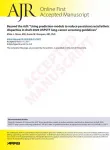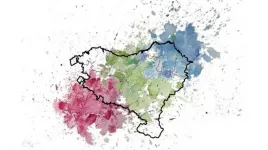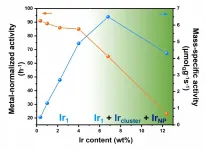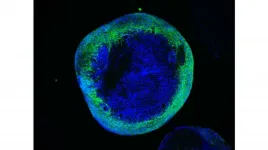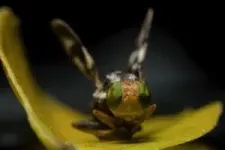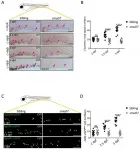Sorting out nanodiamonds with fluorescent centers
2021-03-26
(Press-News.org) Scientists have developed a method to use lasers to control the movement of nanodiamonds with fluorescent centers.
Scientists have long been working on improving their ability to use lasers to move small objects without actually touching them. This method of 'optical trapping and manipulation' is already utilized in optics, biological sciences and chemistry. But objects become much more difficult to control once they grow to nanoscale size.
Now, a team of scientists including Hokkaido University's Keiji Sasaki and Osaka Prefecture University and Osaka University's Hajime Ishihara have found a way to move diamond nanoparticles of about 50 nanometres in diameter, using opposing lasers. Their experiments, published in the journal Science Advances, aim to further research into the development of applications in fields like biological imaging and quantum computing.
"We believe our approach can enable a new class of optical force methodologies to investigate the characteristics of advanced nanomaterials and quantum materials and to develop state-of-the-art nanodevices," says Sasaki.
Nanodiamonds have carbon atom lattices that sometimes contain an imperfection in which two neighbouring carbon atoms are replaced with a nitrogen atom and a vacancy (fluorescent center), which affect their quantum mechanical properties; nanoparticles react to light differently depending on their quantum mechanical property. Nanodiamonds with this fluorescent center (resonant nanodiamonds) absorb green light and emit red fluorescence and are being investigated for applications in biological imaging, sensing and single-photon sources. Nanodiamonds without fluorescent centers are non-resonant.
Sasaki and his colleagues soaked an optical nanofiber in solutions of nanodiamonds with and without fluorescent centers. Shining a green laser through one end of the nanofiber trapped a single nanodiamond with fluorescent centres and transported it away from the laser.
The scientists demonstrated that, when a green and a red laser were shone on the nanodiamonds from opposite sides of the optical nanofiber, the movement of resonant and non-resonant nanodiamonds could be independently controlled: For the non-resonant nanodiamonds, the red laser pushes them more strongly than the green laser; however, the resonant ones absorb the red laser light and are hence pushed more strongly by the green laser. Thus, they could be sorted based on their optical properties. Furthermore, the number of fluorescent centers in the resonant nanodiamonds could be quantified by observing their movements under these conditions.
By using this technique to trap and manipulate nanodiamonds, the scientists have demonstrated a proof of concept. Their next step would be to apply it to organic dye-doped nanoparticles, which can be used as nanoprobes in biodetection systems.
INFORMATION:
ELSE PRESS RELEASES FROM THIS DATE:
2021-03-26
Leesburg, VA, March 26, 2021--According to ARRS' American Journal of Roentgenology (AJR), updated United States Preventive Services Task Force (USPSTF) lung cancer screening (LCS) guidelines based solely on age, pack-years, and quit-years perpetuate eligibility disparities among racial and ethnic minorities, although incorporating certain risk prediction models may help reduce such inequalities.
By pulling data from the 2015 National Health Interview Survey (NHIS), Journal of the National Cancer Institute researchers (Landy et al.) were able to "estimate the effects of USPSTF-2020 guidelines on disparities in LCS eligibility for the non-institutionalized civilian US population," wrote Massachusetts ...
2021-03-26
The Basques are a unique population in Western Europe; their language is not related to any Indo-European language. Furthermore, genetically speaking, they have been considered to have distinct features. However, until now there was no conclusive study to explain the origin of their singularity.
Now, an international research team led by UPF has confirmed that the Basques' genetic uniqueness is the result of genetic continuity since the Iron Age, characterized by periods of isolation and scarce gene flow, and not its external origin in respect of other Iberian populations.
The study, led by David Comas, principal investigator at UPF and at the Institute of Evolutionary Biology (IBE: CSIC-UPF), has involved ...
2021-03-26
Atomically dispersed catalysts have received extensive research attention, because they exhibit excellent activity and unique selectivity for many important catalytic reactions. The atomically dispersed nature of these metal catalysts confers their unique electronic structures as well as designated coordination-unsaturated environments for the optimized adsorption/activation of the reactants. One grand challenge faced by these atomically dispersed catalysts is that the supported isolated metal \atoms are usually thermally unstable and tend to aggregate into large clusters/particles at evaluated reaction temperatures. As a result, most reported atomically dispersed catalysts have an extremely low metal loading below ...
2021-03-26
Every year, millions of people around the world are displaced from their homes due to severe weather caused by climate change. According to the International Red Cross and Red Crescent Movement, 10.3 million people were displaced as a result of climate-?related events in the last six months alone - four times the number displaced by war and conflict in the same period. One of the main causes of displacement is flooding. A recent example is the situation in eastern Australia, where tens of thousands of people are having to flee their homes to seek safety from this hundred-?year flood.
An international research team led by the Weather ...
2021-03-26
The skin is the largest organ in the human body, and its outermost part, called the epidermis, is replenished every three weeks. The cells fueling this renewal of the epidermal stem cells, found in specialized areas or niche, within a region of the hair follicle (or root) is known as the 'bulge compartment'. The bulge compartment resident stem cells are multipotent meaning that they can contribute to the repair of skin when it's injured, and also regenerate the hair follicles during normal development. While several groups have focused attention on the stem cells themselves, less is known about niche or extrinsic factors that influence the state of these stem cells.
In the recent paper published in the Developmental Cell, ...
2021-03-26
Leigh syndrome is the most severe mitochondrial disease in children. It causes severe muscle weakness, movement defects, and intellectual disabilities. It usually leads to death within the first years of life. No causative treatment is currently available. One of the genes frequently mutated in patients is SURF1, which encodes for a protein involved in the process of energy generation in the cells. Animal models did not recapitulate the defects seen in the patients carrying mutations in SURF1. Therefore, the scientists did not have the tool to start understanding the disease mechanisms and to identify possible targets for treatment. They report about the first ...
2021-03-26
Apple flies have fascinated scientists right from the mid-19th century, as they are a captivating example of speciation, the beginning of a new species. Correspondence between Charles Darwin and Benjamin Walsh, who observed the apple flies and hawthorn flies in North America, began the rich history of this scientific question in evolutionary biology. When settlers in North America introduced apple trees to the region, what happened within the hawthorn flies to make them shift to this new host plant in the last 300 years?
Continuing the 160-year-old inquiry into the origins of the apple fly, a team of scientists from around the world has just published their research in the Proceedings of the Royal Society B. The researchers span three continents, from the National Centre for Biological ...
2021-03-26
Hematopoietic stem/progenitor cells (HSPCs) include hematopoietic stem cells and several lineage-biased hematopoietic progenitor cells, which can provide all blood cell types in an adult organism. Among them, hematopoietic stem cells have the ability of self-renewal and multi-lineage differentiation, and can rapidly respond under acute hematopoietic conditions. Meanwhile, the hematopoietic progenitor cells can maintain the supply of blood cells in homeostatic hematopoiesis. In a word, HSPCs are the core of the blood system, once their homeostasis is destroyed, it will lead to serious blood diseases and even death. Therefore, the researches associated with the HSPCs can provide a strong support for relevant ...
2021-03-26
Almost all wild canines in Australia are genetically more than half dingo, a new study led by UNSW Sydney shows - suggesting that lethal measures to control 'wild dog' populations are primarily targeting dingoes.
The study, published today in Australian Mammalogy, collates the results from over 5000 DNA samples of wild canines across the country, making it the largest and most comprehensive dingo data set to date.
The team found that 99 per cent of wild canines tested were pure dingoes or dingo-dominant hybrids (that is, a hybrid canine with more than 50 per cent dingo genes).
Of the remaining ...
2021-03-26
Irvine, Calif., March 25, 2021 -- A short-term intervention in daily fiber consumption can significantly alter the gut microbiome and nutrient intake, according to a study led by University of California, Irvine researchers. The research was recently published by the American Society for Microbiology.
Dietary fiber consists of resistant carbohydrates found in fruits, vegetables and whole grains. Fiber persists in our digestion system, and while not digestible by humans, our gut bacteria can metabolize fiber into short-chain fatty acids and other byproducts critical to human health.
Currently, the average person in North America consumes less than 50 percent of the recommended dietary ...
LAST 30 PRESS RELEASES:
[Press-News.org] Sorting out nanodiamonds with fluorescent centers
